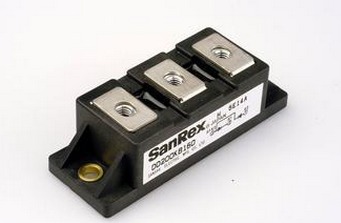 According to iSuppli's research, China's IGBT market will grow rapidly in the next few years, and its sales in 2014 will rise from 430 million U.S. dollars in 2009 to 975 million U.S. dollars, which will more than double. It is estimated that by 2015, 40% to 50% of the growth in the global high-power power electronics market will come from China.
According to iSuppli's research, China's IGBT market will grow rapidly in the next few years, and its sales in 2014 will rise from 430 million U.S. dollars in 2009 to 975 million U.S. dollars, which will more than double. It is estimated that by 2015, 40% to 50% of the growth in the global high-power power electronics market will come from China. Currently, the main IGBT suppliers at home and abroad are: Mitsubishi Electric, Fuji Electric, ST, Vishay, Infineon (EUPEC), Semikron, IXYS, ABB, Hitachi, Korea LS, Japan Sansha, Toshiba, IR, Renesas, Fairchild. , Anson, BYD, Jiaxing Star, CNR Xi'an Yongdian, Jiangsu Hongwei Technology, Nanjing Yinmao, Wuxi Phoenix, Weihai Xinjia, China South Locomotive.
China's well-known IGBT distributors include: Beijing Tongchuang Huida Technology Co., Ltd., Leidu Electronics, Avnet, Pengyuan Electronics, Sajing Power Electronics Group, Shenzhen Lichanghua Electronics, Beijing Wanli Yingda, Beijing Haocheng Jiatai, Controlled release technology, Beijing Jingchuan Electronics, Beijing Guli Tongda, Shanghai Fuyuan Electronics.
The IGBT demand mainly comes from the rapid development of the emerging UHV AC/DC transmission grid, high-speed railway and metro market. According to Zhang Zhengling, director of the National Grid Development and Planning Department, the UHV smart grid will be the basic national policy for the future development of China's electricity. In the next five years, the State Grid will invest 620 billion yuan to build 20 UHV lines to bring southwestern hydropower and the northwest Wind power is transmitted to eastern China.
Up to now, China’s UHV power grid has completed one UHV AC line and two UHV DC lines, totaling 4,633 kilometers. There are 2 AC and 2 DC lines under construction, covering 6412 kilometers.
China's 2020 railway transportation development plan is to achieve 120,000 km of operating mileage and more than 18,000 km of passenger dedicated lines. By 2020, China will build high-speed railways of 2,000 to 18,000 kilometers, and electrified railways will reach 50%, with major technical equipment reaching or approaching the international advanced level.
Among them, the four vertical and four horizontal development plans for the China High Speed ​​Passenger Line are:
Four vertical: Beijing-Shanghai: A total length of 13,18 kilometers, running through Beijing, Tianjin, Shanghai and Anhui, Shandong, Shandong, Shandong and Shandong provinces, connecting the two major economic zones. Beijing-Wuhan-Guangzhou-Shenzhen: It has a total length of about 2,260 kilometers and connects North China and South China. Beijing - Shenyang - Harbin (Dalian): A total length of approximately 1,700 kilometers connects the Northeast and Guan Nei areas. Hangzhou-Ningbo-Fuzhou-Shenzhen: A total length of about 1600 kilometers connects the Yangtze River, the Pearl River Delta, and the southeast coastal areas.
Siheng: Xuzhou-Zhengzhou-Lanzhou: A total length of about 1400 kilometers, connecting the northwest and east China. Hangzhou-Nanchang-Changsha: A total length of about 880 kilometers connects Central and East China Qingdao-Shijiazhuang-Taiyuan: It is about 770 kilometers long and connects North China and East China. Ning Hanrong (Nanjing-Chengdu): A total length of about 1,600 kilometers connects the southwest and east China.
Urban rail transit in China is also developing very rapidly. The current specific development plans are: 16 cities under construction; more than 40 lines in more than 20 cities have been approved; more than 300 subways or light rails will be planned for 4,500 km in the future; in 2050, the length of urban rails will reach 9,000 km.
Passenger rail transit has planned to build more than 1,000 high-speed EMUs of 300~350km/h and more than 2000 high-speed EMUs of 200~250km/h, and an 8-car 250km/h EMU needs 4-5 sets of traction converters and auxiliary transformers. Flowmeters, an 8-cylinder 350km/h high-speed EMU requires 6-8 traction converters and auxiliary converters, and the capacity of each traction converter is 1200kVA~1600kVA, each set requires an IGBT device: 6500V / 600A or 3300V/1200A, that is, at least 18000 IGBTs are required.
In terms of freight rail transportation, at present, heavy-load freight railways have been planned to require high-power locomotives with 120km/h and 5000t high-power locomotives with more than 2000 columns. Each high-speed high-power AC drive electric locomotive needs 6-8 sets of traction converters. The capacity of each traction converter is 1200kVA~1600kVA. Each set requires one IGBT device: 6500V/600A or 3300V/1200A, that is, at least 16000 IGBTs are needed.
Led Driver,Mini Led Driver,100W Led Driver,100W Led Driver
Ninghai Yingjiao Electrical Co., Ltd. , https://www.yingjiaoadapter.com